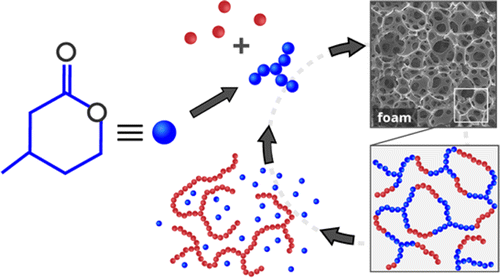Recyclable, sugar-derived foam—a renewable alternative to traditional polyurethanes?

Polyurethanes in products from cushy sofas to stretchy spandex have made sitting, sleeping and walking more comfortable. But once they have served their purpose, most of the non-degradable materials pile up in landfills. Now scientists report in the journal ACS Macro Letters a potential way to reduce future waste: a chemically recyclable foam made using a new sugar-derived material.
Polyurethanes are highly versatile materials. In addition to furniture and clothing, manufactures use them in electronics, cars, floors and medical devices. But the materials come from petroleum, and efforts to recycle them are limited. To tackle the huge amount of waste this creates, scientists are pursuing more sustainable options. Marc A. Hillmyer and colleagues developed an efficient method to make a sugar-derived rubbery polyester compound called poly(β-methyl-δ-valerolactone), or PMVL, that can be used in new chemically-recyclable polyurethanes.
Using this new polymer, the researchers made flexible polyurethane foams that were comparable in performance to commercial analogs. To test whether the foams could be recycled, the team first added a catalyst, then heated the materials to a high temperature. Through this process, the researchers recovered up to 97 percent of the starting β-methyl-δ-valerolactone (MVL) monomer in high purity. The researchers then used what they recovered to re-make PMVL with essentially identical properties.
More information: Deborah K. Schneiderman et al. Chemically Recyclable Biobased Polyurethanes, ACS Macro Letters (2016). DOI: 10.1021/acsmacrolett.6b00193
Abstract
Polyurethanes (PUs), in the form of coatings, adhesives, sealants, elastomers, and foams, play a vital role in the consumer goods, automotive, and construction industries. However, the inevitable disposal of nondegradable postconsumer polyurethane products constitutes a massive waste management problem that has yet to be solved. We address this challenge through the synthesis of biobased and chemically recyclable polyurethanes. Our approach employs renewable and degradable hydroxy telechelic poly(β-methyl-δ-valerolactone) as a replacement for petroleum-derived polyols in the synthesis of both thermoplastic polyurethanes and flexible foams. These materials rival petroleum-derived PUs in performance and can also be easily recycled to recover β-methyl-δ-valerolactone monomer in high purity and high yield. This recycling strategy bypasses many of the technical challenges that currently preclude the practical chemical recycling of PUs.
Journal information: ACS Macro Letters
Provided by American Chemical Society



















